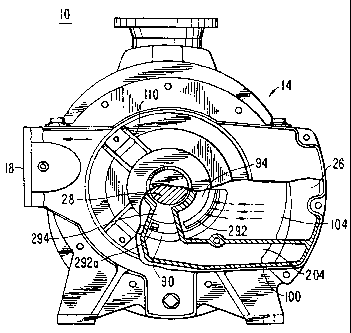Une partie des informations de ce site Web a été fournie par des sources externes. Le gouvernement du Canada n'assume aucune responsabilité concernant la précision, l'actualité ou la fiabilité des informations fournies par les sources externes. Les utilisateurs qui désirent employer cette information devraient consulter directement la source des informations. Le contenu fourni par les sources externes n'est pas assujetti aux exigences sur les langues officielles, la protection des renseignements personnels et l'accessibilité.
L'apparition de différences dans le texte et l'image des Revendications et de l'Abrégé dépend du moment auquel le document est publié. Les textes des Revendications et de l'Abrégé sont affichés :
| (12) Brevet: | (11) CA 2226799 |
|---|---|
| (54) Titre français: | POMPES A DEUX ETAGES A ANNEAU LIQUIDE |
| (54) Titre anglais: | TWO-STAGE LIQUID RING PUMPS |
| Statut: | Durée expirée - au-delà du délai suivant l'octroi |
| (51) Classification internationale des brevets (CIB): |
|
|---|---|
| (72) Inventeurs : |
|
| (73) Titulaires : |
|
| (71) Demandeurs : |
|
| (74) Agent: | GOWLING WLG (CANADA) LLP |
| (74) Co-agent: | |
| (45) Délivré: | 2007-09-25 |
| (22) Date de dépôt: | 1998-01-13 |
| (41) Mise à la disponibilité du public: | 1998-07-30 |
| Requête d'examen: | 2002-10-23 |
| Licence disponible: | S.O. |
| Cédé au domaine public: | S.O. |
| (25) Langue des documents déposés: | Anglais |
| Traité de coopération en matière de brevets (PCT): | Non |
|---|
| (30) Données de priorité de la demande: | ||||||
|---|---|---|---|---|---|---|
|
La pompe annulaire à deux étages pour liquide a une structure qui favorise la séparation des gaz et des liquides déchargés du premier étage. Le deuxième étage est pourvu d'orifices d'admission séparés des gaz et des liquides. Cela évite l'étranglement par un liquide de l'orifice d'admission des gaz du deuxième étage, d'où de meilleures performances de la pompe.
A two-stage liquid ring pump has an interstage structure which promotes separation of the gas and liquid discharged from the first stage. The second stage has separate gas and liquid inlets for respectively admitting the separated gas and liquid to the second stage. This avoids any possible choking of the second stage gas inlet by liquid, thereby improving the performance of the pump.
Note : Les revendications sont présentées dans la langue officielle dans laquelle elles ont été soumises.
Note : Les descriptions sont présentées dans la langue officielle dans laquelle elles ont été soumises.

2024-08-01 : Dans le cadre de la transition vers les Brevets de nouvelle génération (BNG), la base de données sur les brevets canadiens (BDBC) contient désormais un Historique d'événement plus détaillé, qui reproduit le Journal des événements de notre nouvelle solution interne.
Veuillez noter que les événements débutant par « Inactive : » se réfèrent à des événements qui ne sont plus utilisés dans notre nouvelle solution interne.
Pour une meilleure compréhension de l'état de la demande ou brevet qui figure sur cette page, la rubrique Mise en garde , et les descriptions de Brevet , Historique d'événement , Taxes périodiques et Historique des paiements devraient être consultées.
| Description | Date |
|---|---|
| Inactive : Périmé (brevet - nouvelle loi) | 2018-01-13 |
| Inactive : TME en retard traitée | 2008-01-18 |
| Lettre envoyée | 2008-01-14 |
| Accordé par délivrance | 2007-09-25 |
| Inactive : Page couverture publiée | 2007-09-24 |
| Lettre envoyée | 2007-07-17 |
| Inactive : Transfert individuel | 2007-07-05 |
| Préoctroi | 2007-07-05 |
| Inactive : Taxe finale reçue | 2007-07-05 |
| Un avis d'acceptation est envoyé | 2007-04-26 |
| Lettre envoyée | 2007-04-26 |
| Un avis d'acceptation est envoyé | 2007-04-26 |
| Inactive : Approuvée aux fins d'acceptation (AFA) | 2007-04-12 |
| Modification reçue - modification volontaire | 2006-08-22 |
| Inactive : Dem. de l'examinateur par.30(2) Règles | 2006-03-29 |
| Inactive : CIB de MCD | 2006-03-12 |
| Modification reçue - modification volontaire | 2006-01-13 |
| Inactive : Dem. de l'examinateur par.30(2) Règles | 2005-07-14 |
| Lettre envoyée | 2003-02-12 |
| Modification reçue - modification volontaire | 2003-01-10 |
| Lettre envoyée | 2002-11-22 |
| Requête d'examen reçue | 2002-10-23 |
| Exigences pour une requête d'examen - jugée conforme | 2002-10-23 |
| Toutes les exigences pour l'examen - jugée conforme | 2002-10-23 |
| Demande publiée (accessible au public) | 1998-07-30 |
| Inactive : CIB en 1re position | 1998-04-30 |
| Symbole de classement modifié | 1998-04-30 |
| Inactive : CIB attribuée | 1998-04-30 |
| Inactive : CIB attribuée | 1998-04-30 |
| Inactive : Certificat de dépôt - Sans RE (Anglais) | 1998-04-06 |
| Demande reçue - nationale ordinaire | 1998-04-04 |
Il n'y a pas d'historique d'abandonnement
Le dernier paiement a été reçu le 2007-01-03
Avis : Si le paiement en totalité n'a pas été reçu au plus tard à la date indiquée, une taxe supplémentaire peut être imposée, soit une des taxes suivantes :
Les taxes sur les brevets sont ajustées au 1er janvier de chaque année. Les montants ci-dessus sont les montants actuels s'ils sont reçus au plus tard le 31 décembre de l'année en cours.
Veuillez vous référer à la page web des
taxes sur les brevets
de l'OPIC pour voir tous les montants actuels des taxes.
Les titulaires actuels et antérieures au dossier sont affichés en ordre alphabétique.
| Titulaires actuels au dossier |
|---|
| GARDNER DENVER NASH LLC |
| Titulaires antérieures au dossier |
|---|
| CARL G. DUDECK |
| RAMESH B. SHENOI |